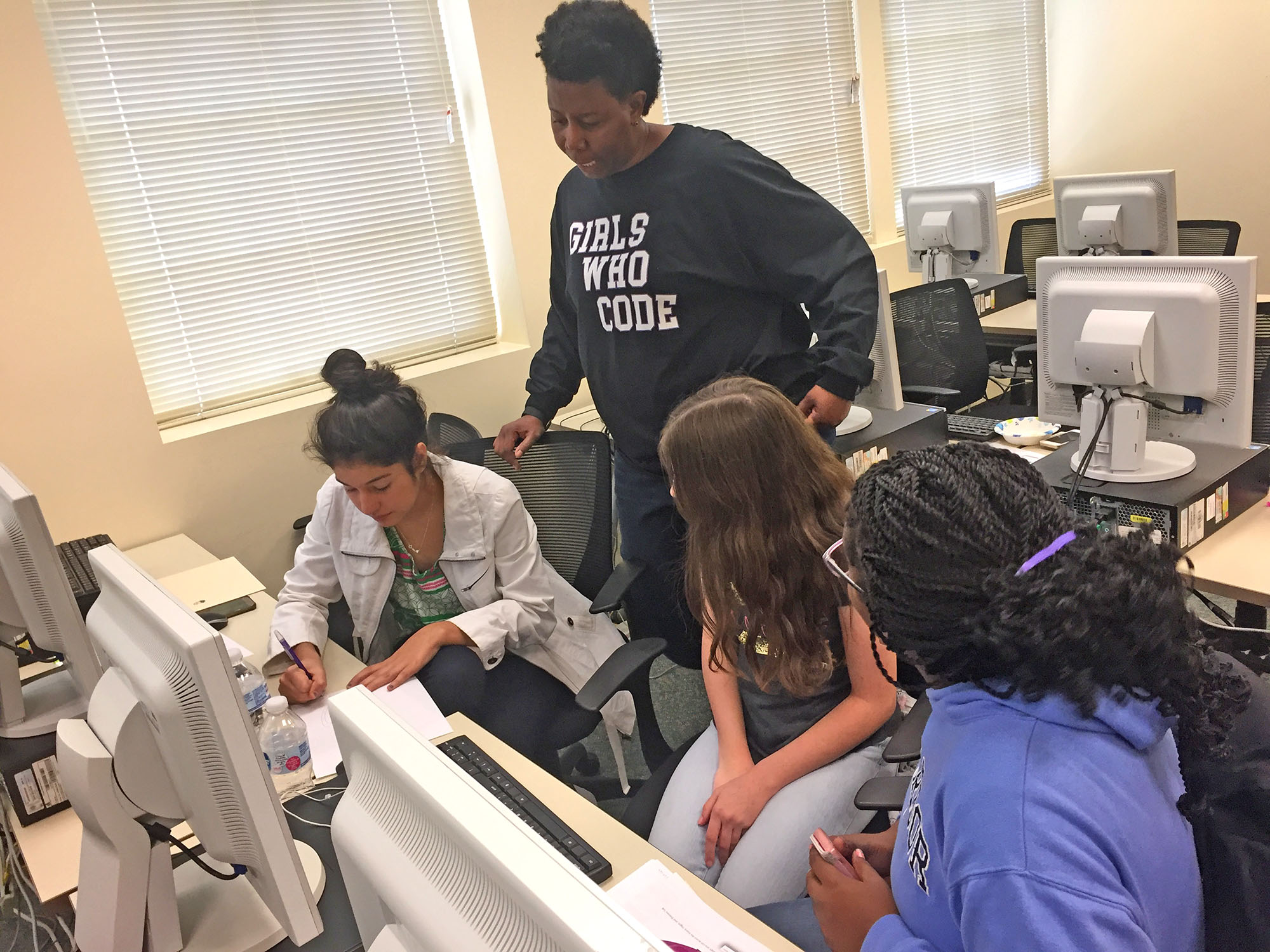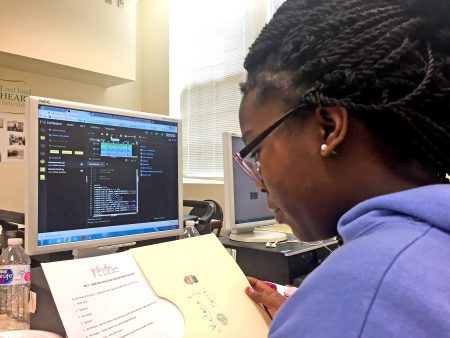
The Healthy Discussions team brainstrom their mission statement for a social networking site for giving and getting advice. [From left: Lili, Angela Sanders, Sophie, Victoria] (Staff photo by Beth Clifford)
At 9 a.m. on every first and third Saturday of the month, a classroom opens at the Community Family Life and Recreation Center at Lyon Park to the students of Girls Who Code.
On Nov. 18, eight middle schoolers ages 11 to 14 marched in, and during the next three hours the girls generated their own websites using the coding skills they learned the previous week, engaged in a variety of team building activities, sang along to Christmas music, giggled frequently, and often took a brain break to travel to the table of overflowing snacks.
By the end of the class Saturday, each student was writing a mission statement and designing a logo with their team for their “computer science (CS) impact project,” which already had a designated project manager, a staff supervisor, a timeline for problem-solving, and a list of the technology tools they need to target a community problem.

Victoria creates her own EDM song. “I’m still looking for a bassdrop.” (Staff photo by Beth Clifford)
This fun-loving, collaborative and productive classroom was the vision Alisha Malloy had three years ago when Rebecca Oats, the executive director of the community center, approached her and asked, “What can we do for girls? They don’t have a program, and it would be wonderful if we did something with technology.” Malloy had the perfect program, and it was Girls Who Code.
“The first objective is definitely sisterhood,” Malloy said of the program’s mission. “Second, we want to expose them to computer technology and actually teach them how to program, but we want to make sure we are doing it in an environment that is safe and empowering.”
Another central part of the program’s mission is to instill a commitment of service in the students. At Saturday’s class after a Pictionary game, there were loud moans and groans from the other side of the classroom when Malloy held up four $1 bills and announced that the winning team earned a prize.
“But there’s a catch,” Malloy said, interrupting the disappointment of the losing side of the room. “Remember, girls, for everything you are given, you give something back. So, for the next homeless person you see, this is your gift to them.”
That focus on service, sisterhood, and side of coding has stayed the same since the VOICE last visited Girls Who Code in its first year of operation. However, Malloy has made major changes to the program and its curriculum since.
The first change has been regarding the target age group. When Girls Who Code started in 2015, they accepted students from 6th through 10th grade. Last year, the classroom ranged from 6th to 12th grade.
Malloy said that with such a large age range, it was difficult to promote a strong sisterhood because, ultimately, middle school girls and high school girls are interested in and conversing about very different things.
This is the main reason why they decided to limit the enrollment to 6th through 8th grade for their third year of operation. With this structure, assistant teacher Angela Sanders said that the bonds are noticeably greater among the students.
Sanders also noted another advantage to targeting middle-school girls specifically.
Sanders is a lead business system analyst at MetLife who volunteers in a variety of community service programs that engage young women in STEM. As a woman who has been in STEM her whole academic and professional career, she has noticed the disparities that disadvantage women in the field. By empowering young girls, she wants to help change that.
“During middle school, they are still figuring out what they want to do,” Sanders said. “This is the time when we lose so many girls in the STEM field, and so now we are making sure our 6th through 8th graders are not losing that interest.”
Malloy described the age change as finding their “sweet spot.”
A second change has also contributed to this year’s program success. During its first year, everyone did essentially the same activities and projects, according to Sanders.
Now, Malloy has completely reworked the curriculum so that students can decide what they want to do through community service (CS) impact projects. Each student works with a small team throughout the entire year, and they collectively identify a community problem they want to solve. This year’s three CS impact project teams are referred to as “Healthy Discussions, Kids in Technology, and Anti-Bullying.”
Together, the members of each team figure out who their audience is, what is going to be their central message, and what technology they will employ to make it happen.
Malloy and her teacher assistants use about an hour of each class to teach a technology tool or program, such as EarSketch, Google Sites, and Wix. The girls then can decide on their own if they want to use that tool or not.
“It makes it tougher on us because we have to differentiate,” Sanders said of the change. “But because they are interested in the topic and choosing their own projects, they are so much more motivated to work on it.”
Victoria, one of Malloy’s 13-year-old students, has used this curriculum change to explore her interest in music production.
By using EarSketch and JavaScript coding, she has created her own EDM song just for fun. “I’m still looking for a code that will give me a bass drop, though,” she said when showing the draft to a classmate.
Victoria is also a part of the Healthy Discussions team, which decided on Saturday that their brand name is going to be “Social Butterfly.”
Sophie, the 13-year-old project manager, described how the name “Social Butterfly” reflects the nature of their idea, which is to create a social networking site for giving and getting advice. Sophie, Victoria, and their third team member Lili collaborated on their shared “Social Butterfly” Google account to create a mission statement and logo during the final hour of Saturday’s class.
As the three teams were having independent work time, the classroom was full of chatter, laughter, and side discussion about this day’s snacks.
“Honestly, the biggest awakening for me is how much they eat,” Malloy laughed.
The Girls Who Code program gets funding from industry sponsors, including Google Fiber, which allows the girls to have ample food while they work-out their brains. This support also allows Malloy to incentivize the students with prizes. At the end of the class in April, the student that has the best exhibited commitment and leadership will be gifted her own personal laptop.
For next year, Malloy’s plan is to continue the successful growth the program has been having over the past three years by incorporating site visits to corporations in the industry. She also wants to increase enrollment for the class by getting the word of the program’s mission out in the community.
“It’s hard for me to describe this program,” Malloy said. “When you hear, “Girls Who Code,” you think they come here, they look at a computer, they don’t interact. That is nothing like what they experience. Coding is a side thing; you’re going to learn how to code and how to develop websites and apps, but what you really learn is how to get along, how to problem-solve, and how to strengthen your leadership skills, and we all end up building a sisterhood.”